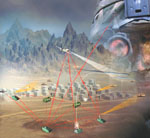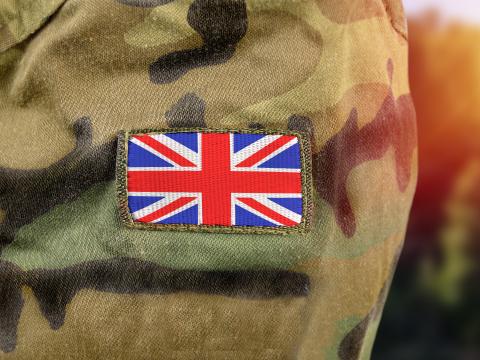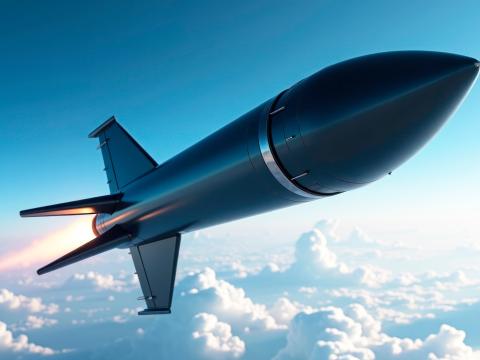Future Combat Systems Progress Remains Uncertain
 |
| The goal of the U.S. Army’s Future Combat Systems (FCS) program is to re-equip its forces with lighter, more mobile and highly networked vehicles. Operating with a host of unmanned aerial and ground vehicles and intelligent munitions, the service plans to increase greatly the situational awareness and lethality of its units. But the scale and complexity of the program have led to a recent series of budget cuts and questions about the Army’s ability to field FCS in its entirety. |
The U.S. Army’s ambitious program to create a lighter, more mobile, networked and lethal force is facing budget cuts and concerns that the complex initiative may not be fully deployed. A recently released Congressional Budget Office report examines Future Combat Systems within the context of the Army’s transformation efforts. It highlights the challenges facing the program and provides alternative approaches to modernizing the service’s combat brigades.
The Congressional Budget Office (CBO) report was commissioned based on testimony and press reports concerning difficulties the program has encountered, especially in its development schedule and procurement cost, explains Douglas Bush, legislative director in the office of Rep. Neil Abercrombie (D-HI). As a member of the House Committee on Armed Services and the ranking member of the Subcommittee on Tactical Air and Land Forces, Rep. Abercrombie initiated the study based on previous experiences with another complex program, the canceled Comanche helicopter. “The concern was if that happened with a single platform [Comanche] that had been touted for so long as being absolutely essential, what are the possible future outcomes for FCS [Future Combat Systems]?” Bush says.
The report is designed to provide subcommittee members with an insight into the cost implications of several different program outcomes. The CBO study was commissioned in early 2005 and released in August 2006. But since 2005, Bush notes, the Army’s financial situation has become more critical.
The first recommendation is to develop and procure FCS components focusing on information collection and dissemination. Under this proposal, the Army would develop and procure unattended ground sensors and all four classes of unmanned aerial vehicles (UAVs) included in the FCS program. It also would develop a less extensive version of the FCS wireless battlefield network and install it in existing armored vehicles. All other FCS components, including manned and unmanned vehicles, the non-line-of-sight launch system and the intelligent munitions system, would be canceled.
The second alternative is to develop components to enhance the Army’s long-range strike capability, allowing the service to retain its ability to carry out precision attacks. This option calls for developing and procuring the program’s unattended ground sensors and long-range UAVs. The service also would develop the non-line-of-sight launch system and its assorted missiles, retain and upgrade its existing armored vehicles and develop a scaled-down version of the FCS network to link sensors and manned systems.
New vehicle types are the focus of the third proposal. It would permit the Army to develop and procure five types of manned vehicles to replace the oldest of its platforms, the M113 family of vehicles and M109 howitzers. The new vehicles and other existing Army platforms such as Abrams tanks would be upgraded so that they could be integrated into a scaled-down FCS network. All the other parts of the FCS program, specifically all four classes of UAVs, all unmanned ground vehicles, unattended ground sensors, the intelligent munitions system, the non-line-of-sight launcher and the remaining three types of manned FCS vehicles would be canceled.
The final alternative suggested by the CBO report would be to retain only the network component of the FCS program. This capability would be a scaled-down version of the currently proposed network that would be installed into existing combat vehicles. The report notes that this approach would require the least amount of hardware and would allow the Army’s combat brigades to benefit from an evolutionary improvement rather than a wholesale conversion to a new and unproven technology.
Bush notes that these possibilities represent ways to modernize the Army short of acquiring the entire FCS program. He explains that Congress is concerned that given the Army’s other expenses, the service will not be able to afford FCS in its entirety. He adds that short-term requirements such as modularity and unit reset from
However, Bush admits that Congress historically has been hesitant to cancel or radically restructure defense programs. “Usually what Congress does is express concern and nibble at the funding until the services get the picture and do it themselves. In this case a possible good outcome would be for the Army to restructure the program under a more realistic path so that it can make an argument for keeping the dollars in the future budget,” he says.
As the program currently stands, FCS is scheduled to introduce its initial capabilities for hardware in Spinout 1 and for software in Build 1. Both of these phases are interrelated, explains Jack Paul, Boeing’s director for FCS strategic business development,
In addition to the sensors that are a part of the three systems being fielded, Spinout 1 will include an early version of the FCS computer, the joint tactical radio system and the FCS network. Key to the entire program, the network consists of the system-of-systems common operating environment (SOSCOE), battle command software and intelligence, surveillance and reconnaissance systems. Paul explains that SOSCOE functions as an operating system, such as Windows, while Battle Command is an application. The software provides the basic ability to network and share information. The applications will allow the three FCS platforms to operate and to merge the sensor feeds from these systems to—and fuse them so they can be shared with—platforms such as M-1 Abrams and Bradley armored fighting vehicles and high mobility multipurpose wheeled vehicles (HMMWVs).
The program is creating a modification kit that can be applied to the Army’s fighting vehicle inventory. Paul notes that the FCS systems will be slightly different for each platform. Spinout 1 platforms and software will be demonstrated with technical and user tests at
Perhaps the greatest technical challenges for FCS is its networking component. Bush observes that ad hoc networking in a land environment is very difficult. Historically, the Navy has been the first to field new systems because it is easier to install equipment on large platforms such as ships. “I think the Army faces additional challenges because of the variables faced in land warfare,” he says.
The networking architecture for FCS will be formed by SOSCOE. Consisting of slightly less than 2 million lines of code, it will perform a series of common functions and services for all of the other applications on the network. For example, all of the information assurance programs will reside in SOSCOE. It also has an interpretation capability, which allows the FCS to communicate with non-FCS network platforms.
When questioned about the network’s survivability and robustness, Paul maintains that it is a totally distributed system without a central node that can fail or be targeted. “The network resides on the 18 FCS platforms. The platforms not only do their primary function as sensors, vehicles or munitions, they all have a computer, software and a communications capability. Each one of those is literally an IP [Internet protocol] node,” he says.
Because every platform is a node in the network, even if one or more systems are destroyed, jammed or disabled, that node will not compromise the network. He explains that the network will continue to function as long as a few vehicle or sensor systems are operating. “It’s very difficult to jam or damage a dispersed network like that,” Paul says.
SOSCOE also features advanced information assurance technologies to defeat attempts to access or compromise the network. Paul claims that the developers applied rigorous standards for detecting and responding to intrusions. This defensive capability operates in the software distributed across the network. The majority of the information assurance applications will reside on the manned ground vehicles because they have the largest computers and all of the system software.
To help reduce risks associated with developing such complex software, Boeing has spread the work out to several different firms so that no one firm will be responsible for all of the work. Paul notes that sharing the risk among an industry team prevents any single firm from coming under too much development pressure. “It allows us to do it modularly, and it allows us to reduce risk. And it allows us to plan for upgrades over time,” he says.
Yet the program’s recent milestones will have little effect on immediate budget allocations, although the milestones might impact the next fiscal year’s. Bush believes that a major concern among congressional staffers is that any problems with the system’s network and software may slow down the program. “People are fairly confident that we can build these platforms, although there are concerns about the level of [vehicle] survivability. But the Army has said from the start that it will make up for the lack of survivability with the network and the knowledge it provides. If you don’t have the network, they’re just 20-ton vehicles,” he says.
Congress also is unclear about the types of conflicts for which the FCS program is preparing. “What kind of wars is the Army optimizing itself for in the future? Insurgency or big wars—which one? That would help guide investment. If we are going to optimize for counterinsurgency, you would see more light stuff, with protected vehicles. But FCS might turn into something that we develop as a technology bed—two or three brigades. But so far, it’s not clear that the Army’s willing to make that internal decision. It might just be that they’re not comfortable doing so because the future is so uncertain,” Bush observes.
Airlifting capability is still an issue for the FCS vehicles because they will be too large to fit into Hercules transport aircraft, the Air Force’s most abundant cargo planes. Bush notes that the CBO study states that the Army has no operational plan that supports the airborne deployment of FCS-based forces. “There is no realistic go-to-war scenario that would envision or require doing that [airlifting]. Because if you need a brigade somewhere just for diplomacy purposes, send the 82nd [Airborne Division],” he says.
However, the Army still needs to be capable of fighting a major ground-based conflict in the future. “The ability to put sustained combat power on the ground somewhere in the world for a while, that’s always been the Army’s forte. They started edging away from that, but I think the war in
Paul admits that although the program has met its current milestones, its budget will be cut in the 2007 defense allocations budget. In late September compromise legislation, the House and Senate agreed to cut $320 million from the program.
The Army is exploring methods to apply the cuts, but Paul notes that the result is that significant parts of the program will be stretched out, although he is not sure what those segments will be. “It’s going to have some significant impacts. This will be the third year in a row that Congress has done a reduction. The cumulative effect on the program is going to mean that some things that we’ve really been trying to hold in place are going to have to move,” he says.
Despite the cuts, Paul notes that there is currently no attempt to eliminate any of the program’s 18 platforms. But there is discussion about extending the development of some of the platforms, he says. “We’re trying very hard not to impact Spinout 1. But in doing that, there is the likelihood that Spinouts 2 and 3 might get impacted,” he shares.
Based on Army estimates established in May 2006, the current cost for FCS in fiscal year 2003 dollars is $120 billion for the research and development, technical evaluation and procurement programs. Paul believes the final cost of the program will be from $161 billion to $165 billion, noting that a 2005 system acquisition report estimates the final cost at $161 billion and a system acquisition report from May 2006 places the cost at $165 billion. This combined cost represents the complete cost of the program, from research and development through procurement.
Web Resource
Future Combat Systems: www.army.mil/fcs



Comments